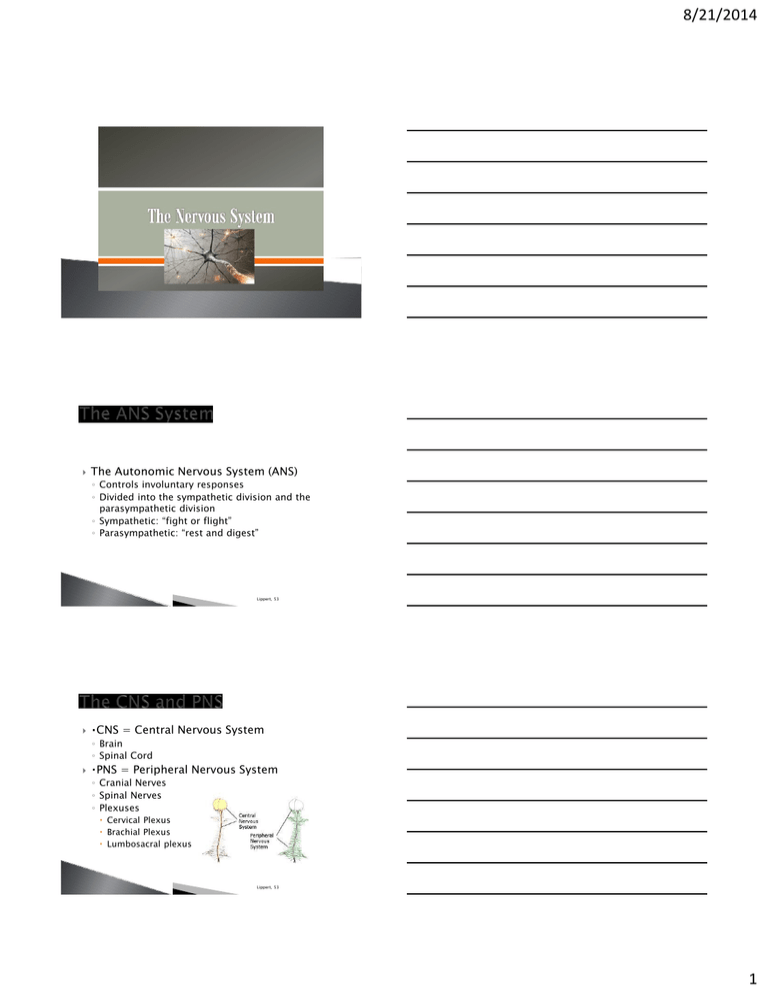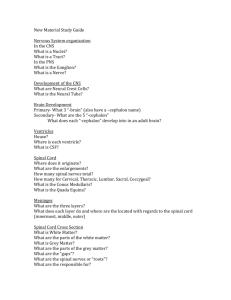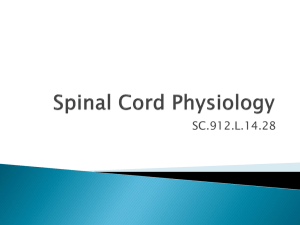The Autonomic Nervous System (ANS) CNS = Central Nervous
advertisement

8/21/2014 The Autonomic Nervous System (ANS) ◦ Controls involuntary responses ◦ Divided into the sympathetic division and the parasympathetic division ◦ Sympathetic: “fight or flight” ◦ Parasympathetic: “rest and digest” Lippert, 53 CNS = Central Nervous System ◦ Brain ◦ Spinal Cord PNS = Peripheral Nervous System ◦ Cranial Nerves ◦ Spinal Nerves ◦ Plexuses Cervical Plexus Brachial Plexus Lumbosacral plexus Lippert, 53 1 8/21/2014 Neurons = Nerve Cells ◦ Contains a cell body, axon and dendrites ◦ Dendrites receive impulses and bring them toward the cell body ◦ axons transmit impulses away from the cell body Lippert, 54 Afferent Nerves = sensory nerves ◦ Conducts afferent impulses from the periphery to the spinal cord ◦ The dendrite is in the skin or peripheral areas and its cell body is located in the posterior aspect of the spinal cord Efferent Nerves = motor nerves ◦ Conducts efferent impulses from the spinal cord to the periphery ◦ The cell body and dendrites for efferent motor nerves are located in the anterior aspect of the spinal cord Lippert, 54-55 The brain is made up of the: ◦ Cerebrum Largest portion Made up of right and left cerebral hemispheres joined together by the corpus callosum •Each hemisphere has 4 lobes: •Frontal Lobe: personality •Occipital Lobe: vision •Parietal Lobe: sensation •Temporal Lobe: behavior ◦ Brainstem ◦ Cerebellum Lippert, 56 2 8/21/2014 Deep within the brain lies the… ◦ Thalamus: pain perception ◦ Hypothalamus: hormone function ◦ Basal Ganglia: coordination of movement Lippert, 56 The brain is made up of the: ◦ Cerebrum (see previous slide) ◦ Brainstem (most of the cranial nerves come from the brainstem area) ◦ Midbrain: visual reflexes ◦ Pons: connects the midbrain to the medulla ◦ Medulla (oblongata): connects to spinal cord, autonomic control of respiration and heart rate ◦ Cerebellum: Muscle coordination, tone and posture Lippert, 56 A continuation of the medulla It runs through the vertebral foramen in each individual vertebra from the medulla oblongata (proximally) to the conus medullaris (distally), at the approx level of the 2nd lumbar vertebra. Let’s take a look at the spinal cord… Lippert, 58 3 8/21/2014 A cross-sectional view of the spinal cord shows both white matter and gray matter. The gray matter is in the center and looks like an “H” or a butterfly. There is an anterior aspect (the anterior horn) and a posterior aspect (the posterior horn) ◦ Posterior horn: transmits sensory impulses ◦ Anterior horn: transmits motor impulses Lippert, 58 “Motor impulses travel from the brain, down the spinal cord, through the anterior horn, and out to the periphery via peripheral nerves.” “Sensory impulses from the periphery travel up the peripheral nerves, into the spinal cord via the posterior horn, then up the spinal cord to the brain.” Lippert, 60 4 8/21/2014 There are 31 pairs of spinal nerves: ◦ ◦ ◦ ◦ ◦ 8 cervical nerves 12 thoracic nerves 5 lumbar nerves 5 sacral nerves 1 coccygeal nerve The first 7 spinal nerves (C1-C7) exit the vertebral column above the corresponding vertebra. (ie the C3 nerve exits proximal to the C3 vertebra) However, all other spinal nerves exit the vertebral columm distal to the corresponding vertebra What about the C8 nerve? Lippert, 60 “Once outside the spinal cord, the anterior (motor) and posterior (sensory) roots join together to form the spinal nerve, which passes through the intervertebral foramen.” Lippert, 60 5 8/21/2014 Dermatome: ◦ The area of skin supplied with the sensory part of a spinal nerve Myotome: ◦ A muscle (or group of muscles) innervated by a single spinal segment Lippert, 62 There are 12 pairs of thoracic spinal nerves. ◦ “With the exception of T1, which is part of the brachial plexus, thoracic nerves do not join with other nerves to form a plexus.” ◦ Each of these thoracic nerves branches into a posterior and anterior branch. Posterior branch: innervates the back muscles (motor) and the overlying skin (sensory) Anterior branches become intercostal nerves, which innervate the anterior trunk and intercostal muscles (motor) as well as the skin on the anterior and lateral trunk (sensory) Lippert, 63 6 8/21/2014 With the exception of the thoracic nerves, spinal nerves join together and/or branch out, forming a network known as a plexus. There are 3 major plexuses: ◦ Cervical C1-C4 Neck muscles ◦ Brachial C5-T1 Upper Extremity muscles ◦ Lumbosacral L1-S5 Lower Extremity muscles Lumbar portion (L1-L4): supplies mostly thigh muscles Sacral portion (L5-S3): supplies mostly leg & foot muscles 7





